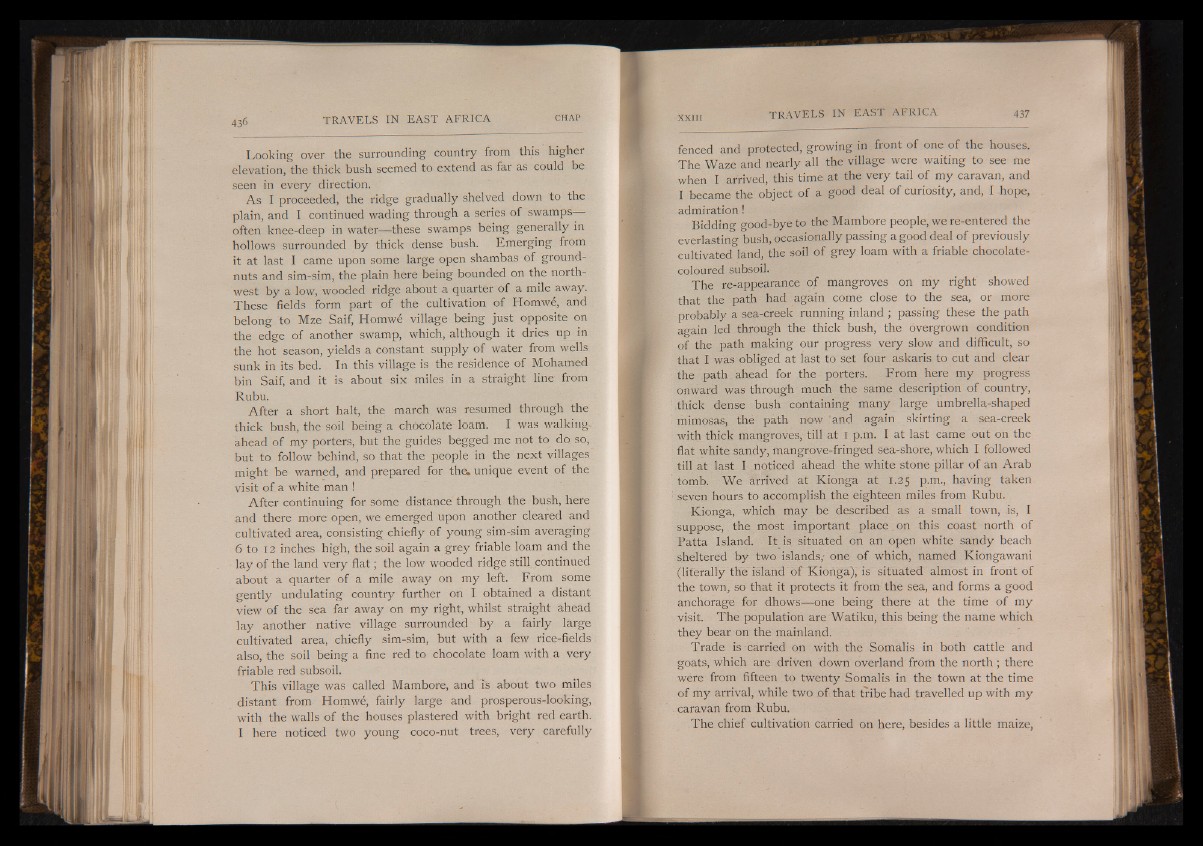
Looking over the surrounding country from this higher
elevation, the thick bush seemed to extend as far as could be
seen in every direction.
As I proceeded, the ridge gradually shelved down to the
plain, and I continued wading through a series of swamps—
often knee-deep in water— these swamps being generally in
hollows surrounded by thick dense bush. Emerging from
it at last I came upon some large open shambas of groundnuts
and sim-sim, the plain here being bounded on the northwest
by a low, wooded ridge about a quarter of a mile away.
These fields form part of the cultivation of Homw6, and
belong to Mze Saif, Homw6 village being just opposite on
the edge of another swamp, which, although it dries up in
the hot season, yields a constant supply of water from wells
sunk in its bed. In this village is the residence of Mohamed
bin Saif, and it is about six miles in a straight line from
Rubu.
After a short halt, the march was resumed through the
thick bush, the soil being a chocolate- loam. I was walking-
ahead of my porters, but the guides begged me not to do so,
but to follow behind, so that the people in the next villages
might be warned, and prepared for the* unique event of the
visit of a white man !
After continuing for some distance through the bush, here
and there more open, we emerged upon another cleared and
cultivated area, consisting chiefly of young sim-sim averaging
6 to 12 inches high, the soil again a grey friable loam and the
lay of the land very flat; the low wooded ridge still continued
about a quarter of a mile away on my left. From some
gently undulating country further on I obtained a distant
view of the sea far away on my right, whilst straight ahead
lay another native village surrounded by a fairly large
cultivated area, chiefly sim-sim, but with a few rice-fields
also, the soil being a fine red to chocolate loam with a very
friable red subsoil.
This village was called Mambore, and fe about two miles
distant from Homw6, fairly large and prosperous-looking,
with the walls of the houses plastered with bright red earth.
I here noticed two young coco-nut trees, very carefully
fenced and protected, growing in front of one of the houses.
The Waze and nearly all the village were waiting to see me
when I arrived, this time at the very tail of my caravan, and
I became the object of a good deal of curiosity, and, I hope,
admiration!
Bidding good-bye to the Mambore people, we re-entered the
everlasting bush, occasionally passing a good deal of previously
cultivated land, the soil of grey loam with a friable chocolatecoloured
subsoil.
The re-appearance of mangroves on my right showed
that the path had again come close to the sea, or more
probably a sea-creek running inland ; passing these the path
again led through the thick bush, the overgrown condition
of the path making our progress very slow and difficult, so
that I was obliged at last to set four askaris to cut and clear
the path ahead for the porters. From here my progress
onward was through much the same description of country,
thick dense bush containing many large umbrella-shaped
mimosas, the path now and again skirting a sea-creek
with thick mangroves, till at I p.m. I at last came out on the
flat white sandy, mangrove-fringed sea-shore, which I followed
till at last I noticed ahead the white stone pillar of an Arab
tomb. We arrived at Kionga at 1.25 p.m., having taken
seven hours to accomplish the eighteen miles from Rubu.
Kionga, which may be described as a small town, is, I
suppose, the most important place on this coast north of
Patta Island. It is situated on an open white sandy beach
sheltered by two islands,- one of which, named Kiongawani
(literally the island of Kionga),' is situated almost in front of
the town, so that it protects it from the sea, and forms a good
anchorage for dhows— one being there at the time of my
visit. The population are Watiku, this being the name which
they bear on the mainland.
Trade is carried on with the Somalis in both cattle and
goats, which are driven down overland from the north ; there
were from fifteen to twenty Somalis in the town at the time
of my arrival, while two o f that tribe had travelled up with my
caravan from Rubu.
The chief cultivation carried on here, besides a little maize,